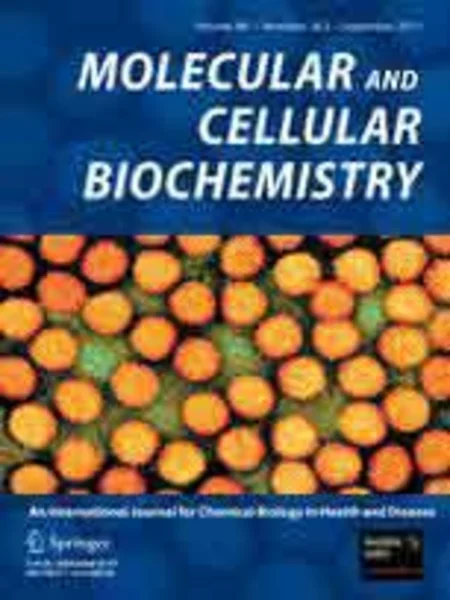-
molecular cloning, characterization, and expression of hsp60 in caudal fin regeneration of misgurnus anguillicaudatus
جزئیات بیشتر مقاله- تاریخ ارائه: 1392/07/24
- تاریخ انتشار در تی پی بین: 1392/07/24
- تعداد بازدید: 1207
- تعداد پرسش و پاسخ ها: 0
- شماره تماس دبیرخانه رویداد: -
urodele amphibians and teleost fish are capable of nearly perfect regeneration of lost appendages. the fin constitutes an important model for studying the molecular basis of tissue regeneration. it has been known that heat shock protein 60 (hsp60) is a multifunctional protein of the heat shock protein family. the purpose of this study is to investigate the role of hsp60 as a part of a stress response system after fin injury or in fin regeneration. we firstly cloned full-length cdna of hsp60 frommisgurnus anguillicaudatus (designated as mahsp60) by race method. the cdna contains a 83-bp 5′utr, a 1,728-bp open reading frame encoding 492 amino acids and a 542-bp 3′utr (accession no.: kf537340). the phylogenetic tree shows that the mahsp60 fits within the hsp60 clade. then quantitative rt-pcr detected that mahsp60 began to increase rapidly its expression at 1 dpa and reached its peak at 2 dpa. next, spatial distribution analysis of mahsp60 in fins showed that mahsp60 located mainly in the deeper layer of regenerated epidermis when mahsp60 expressed most. after the mahsp60 had been cloned into the pet-32a vector, sds-page analysis confirmed that the mahsp60 protein was efficiently expressed in escherichia coli bl21 and adjustable with the temperature. these findings have revealed that mahsp60, a highly conserved gene during vertebrate evolution as well as related to stress response, is involved in the formation of wound epidermis which occurs as the first phase of fin regeneration after fin amputation in caudal fin regeneration.
مقالات جدیدترین رویدادها
-
استفاده از تحلیل اهمیت-عملکرد در ارائه الگوی مدیریت خلاقیت سازمانی و ارائه راهکار جهت بهبود
-
بررسی تاثیر ارزش وجوه نقد مازاد بر ساختار سرمایه شرکت های پذیرفته شده در بورس اوراق بهادار تهران
-
بررسی تأثیر سطح افشای ریسک بر قرارداد بدهی شرکت های پذیرفته شده در بورس اوراق بهادار تهران
-
بررسی تأثیر رتبه بندی اعتباری مبتنی بر مدل امتیاز بازار نوظهور بر نقد شوندگی سهام با تأکید بر خصوصی سازی شرکت ها
-
تأثیر آمیخته بازاریابی پوشاک ایرانی بر تصویر ذهنی مشتری پوشاک ایرانی (هاکوپیان)
-
بررسی رفتار ساختمان های بتن آرمه بهسازی شده با دیوارهای برشی آلومینیومی
-
ارزیابی درجه تراکم دانه بندی گسسته و پیوسته سنگدانه ها در حالت دو بعدی
-
بررسی طراحی بهینه و عملکرد لرزه ای میراگرهای ویسکوز الحاقی در نواحی زلزله خیز
-
طرح دعاوی خصوصی از نظر ضمان قهری و ضررو زیان وارد در دادگاه های عمومی
-
بررسی نحوه طراحی و رتبه بندی سایت در سامانه leed و breeam و امکان سنجی آن با مقررات ملی ساختمان در ایران
مقالات جدیدترین ژورنال ها
-
مدیریت و بررسی افسردگی دانش آموزان دختر مقطع متوسطه دوم در دروان کرونا در شهرستان دزفول
-
مدیریت و بررسی خرد سیاسی در اندیشه ی فردوسی در ادب ایران
-
واکاوی و مدیریت توصیفی قلمدان(جاکلیدی)ضریح در موزه آستان قدس رضوی
-
بررسی تاثیر خلاقیت، دانش و انگیزه کارکنان بر پیشنهادات نوآورانه کارکنان ( مورد مطالعه: هتل های 3 و 4 ستاره استان کرمان)
-
بررسی تاثیر کیفیت سیستم های اطلاعاتی بر تصمیم گیری موفق در شرکتهای تولیدی استان اصفهان (مورد مطالعه: مدیران شرکتهای تولیدی استان اصفهان)
-
نقش صله رحم در سلامت جسمی و روحی خانواده با تمرکز بر گزاره های اسلامی
-
بررسی تاثیر یارانه سفر بر توسعه گردشگری؛ مطالعه موردی: گردشگران شهر مشهد مقدس
-
evaluate the use of recycled asphalt pavement (rap) in the construction of roller compacted concret pavement (rcc)
-
the transformation of aesthetics in architecture from traditional to modern architecture: a case study of the yoruba (southwestern) region of nigeria
-
exploring in silico drug design and pharmacokinetics study for identification of potent antidepressant agents




سوال خود را در مورد این مقاله مطرح نمایید :